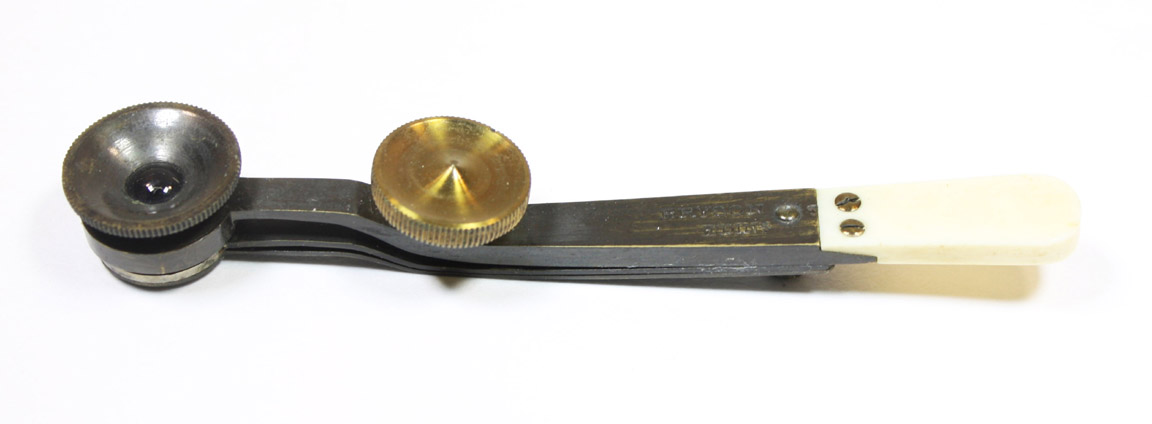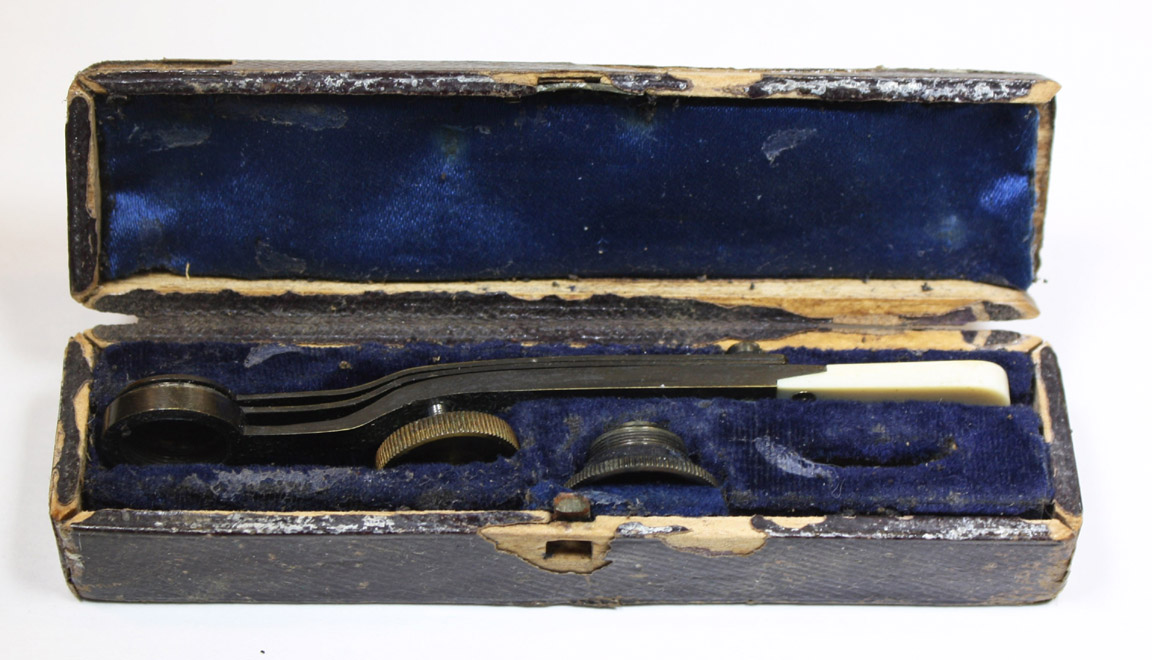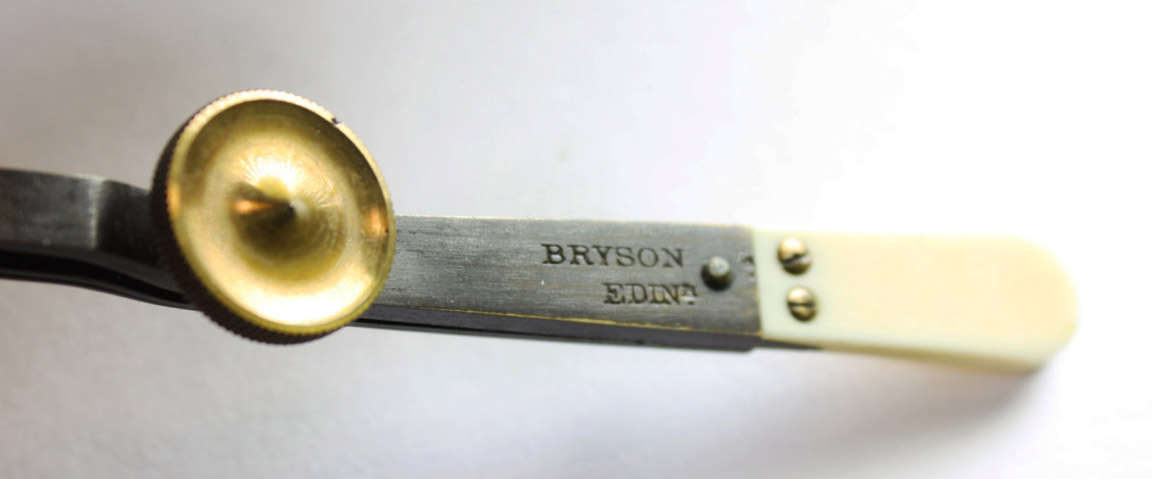DESCRIPTION:
This microscope, from the collection of Dr Brian Stevenson, is an example of the improved form of Gairdner's simple microscope made by Bryson. It measures about four inches in length. It features three leaves of brass held together by a single screw near the ivory handle. It is signed 'BRYSON, EDINB.' on the top most leaf. The top most leaf can accept one of two Wollaston doublets which screw in. A focusing screw passes through the top leaf to act on the middle leaf, which comes closer to the lens when it is unscrewed and is pushed further away when it is screwed in. The top of the focusing screw is a knurled knob of lacquered brass. The middle leaf has a thin cover glass cemented to its surface facing away from the lens. The third leaf can have a cover glass cemented to the surface towards the lens, thus the two together can house the solid or liquid specimen. If the two are gently spread apart, a glass slide with cover slip could also fit between them, this then reflecting one of the improvements of this model. The instrument is housed in a blue velvet-lined case with blue silk lining on the lid. The outside of the case is covered with black leather. The outer case length is about 4 3/8 inches.
HISTORY OF THIS MICROSCOPE
 In its original form(left), this instrument was invented about 1850 by Dr William T. Gairdner of Edinburgh. An example of the original form of Gairdner microscope is in the Golub collection at the University of California Berkeley. Gairdner was a Professor of Medicine at the University of Glascow, and was elected a Fellow of the Royal College of Physicians of Edinburgh also in 1850. James McKay Bryson operated in Edinburgh from 1850 to 1893. As originally invented, the Gairdner microscope had only two leaves, one to hold the lens, the other to hold the specimen. The magnification in this original model was fixed. If one desired more than one magnification, it would require owning more than one microscope. This model was apparently first publicized in Carpenter's 'The Microscope and its Revelations' of 1856. It was there that its use for urinalysis, and other things was suggested. Later on, with suggestions from others, Bryson supplied the form seen at the top of this page, with two leaves to hold the specimen and a third leaf to hold interchangeable lenses. It is unknown when he ceased manufacturing this model of microscope. Apparently none have serial numbers.
In its original form(left), this instrument was invented about 1850 by Dr William T. Gairdner of Edinburgh. An example of the original form of Gairdner microscope is in the Golub collection at the University of California Berkeley. Gairdner was a Professor of Medicine at the University of Glascow, and was elected a Fellow of the Royal College of Physicians of Edinburgh also in 1850. James McKay Bryson operated in Edinburgh from 1850 to 1893. As originally invented, the Gairdner microscope had only two leaves, one to hold the lens, the other to hold the specimen. The magnification in this original model was fixed. If one desired more than one magnification, it would require owning more than one microscope. This model was apparently first publicized in Carpenter's 'The Microscope and its Revelations' of 1856. It was there that its use for urinalysis, and other things was suggested. Later on, with suggestions from others, Bryson supplied the form seen at the top of this page, with two leaves to hold the specimen and a third leaf to hold interchangeable lenses. It is unknown when he ceased manufacturing this model of microscope. Apparently none have serial numbers.
The author is indebeted to Dr Brian Stevenson for sharing his images of this microscope with me so I may share them with you. His website, Historical Makers of Microscopes and Microscope Slides is a treasure trove of information on microscopes and especially microscope slides. I consult it often and so should the reader!






 In its original form(left), this instrument was invented about 1850 by Dr William T. Gairdner of Edinburgh. An example of the original form of Gairdner microscope is in the Golub collection at the University of California Berkeley. Gairdner was a Professor of Medicine at the University of Glascow, and was elected a Fellow of the Royal College of Physicians of Edinburgh also in 1850. James McKay Bryson operated in Edinburgh from 1850 to 1893. As originally invented, the Gairdner microscope had only two leaves, one to hold the lens, the other to hold the specimen. The magnification in this original model was fixed. If one desired more than one magnification, it would require owning more than one microscope. This model was apparently first publicized in Carpenter's 'The Microscope and its Revelations' of 1856. It was there that its use for urinalysis, and other things was suggested. Later on, with suggestions from others, Bryson supplied the form seen at the top of this page, with two leaves to hold the specimen and a third leaf to hold interchangeable lenses. It is unknown when he ceased manufacturing this model of microscope. Apparently none have serial numbers.
In its original form(left), this instrument was invented about 1850 by Dr William T. Gairdner of Edinburgh. An example of the original form of Gairdner microscope is in the Golub collection at the University of California Berkeley. Gairdner was a Professor of Medicine at the University of Glascow, and was elected a Fellow of the Royal College of Physicians of Edinburgh also in 1850. James McKay Bryson operated in Edinburgh from 1850 to 1893. As originally invented, the Gairdner microscope had only two leaves, one to hold the lens, the other to hold the specimen. The magnification in this original model was fixed. If one desired more than one magnification, it would require owning more than one microscope. This model was apparently first publicized in Carpenter's 'The Microscope and its Revelations' of 1856. It was there that its use for urinalysis, and other things was suggested. Later on, with suggestions from others, Bryson supplied the form seen at the top of this page, with two leaves to hold the specimen and a third leaf to hold interchangeable lenses. It is unknown when he ceased manufacturing this model of microscope. Apparently none have serial numbers.